- Home
- Cambridgeshire walks
- English Bluebells
Wild English Bluebells at Brampton Wood
From late April to early June each year, something magical happens in some of England's woodlands
A sea of delicate blue flowers blankets the ground, creating an enchanting scene that's hard to put into words.
These are English bluebells - a native species that has inspired poets, artists, and nature lovers for centuries.
English bluebells flower for only a few weeks each year. This fleeting beauty makes them a symbol of everlasting love in stories and folklore.
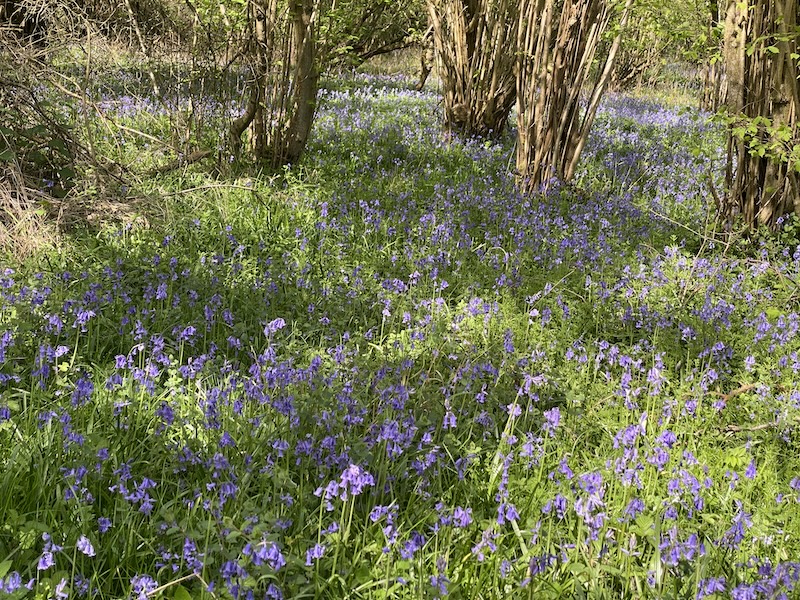
Enjoying Brampton Wood
Join me as I wander through Brampton Wood in Cambridgeshire, the second largest ancient woodland in the county.
The wood's roots can be traced back to the Doomsday Book, which dates it to be at least 900 years old. Since 1992, The Wildlife Trusts of Bedfordshire, Cambridgeshire and Northamptonshire have been taking great care to restore its natural beauty.
When spring arrives and the bluebells flower, I go out with my camera to try to capture this brief moment of enchantment.
Finding the bluebells
 The information centre at Brampton Wood
The information centre at Brampton WoodEntering the wood, bluebells appear in pockets, but their full glory lies deeper within.
The best display is in a corner of Brampton Wood, reachable by two routes.
- From the main gate near the small car park, go to the information centre and take the right pathway behind it, following the wood's edge. Note that this route can be very muddy and sometimes impassable in April.
- Alternatively, take the wide grassy Main Ride pathway, turn right at the Cross Ride, and follow the slope until it flattens out, reaching the same corner of the wood.

There are some unspoken rules. Respect and preserve the natural environment. Stay on the designated paths, do not trample the flowers (nor allow your dog to do so) and never pick them.
Be mindful of other visitors and avoid disturbing wildlife.
 Cross Ride leading to the corner where the bluebells bloom
Cross Ride leading to the corner where the bluebells bloomThe best time to photograph bluebells
Timing is everything when it comes to bluebell photography.
Visit the wood early in the morning or late in the afternoon when the light is soft and diffused making the flowers appear more vibrant and saturated in colour.
The flowers bloom at different times, depending on the location and weather conditions.
Gentle spring showers do not necessarily prevent photography, but heavy rainfall may wash out colours and make woodland pathways muddy and treacherous.
The photo below was taken on a showery day, as you can see from the damp, muddy pathway below.
Despite the light drizzle, the soft, overcast lighting created a beautiful, moody atmosphere, allowing me to capture the delicate details of the bluebells' nodding heads and the bright green of the surrounding foliage.
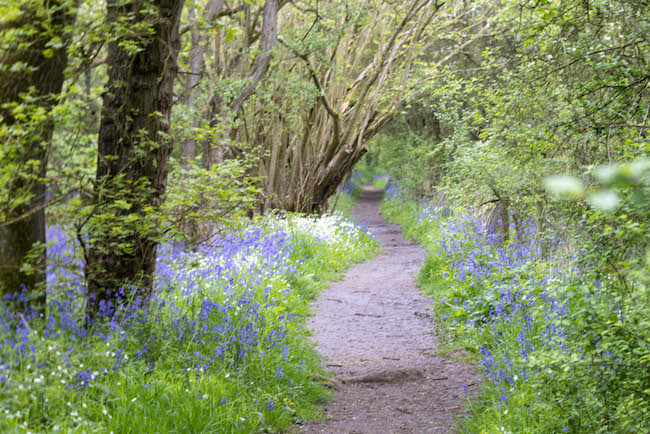 The muddy path through the bluebell woods
The muddy path through the bluebell woodsPhotographing bluebells
My equipment and settings
I bring a camera, tripod, and different lenses with me. This often includes a close-up lens that allows me to capture intricate details of the flowers, revealing their beauty and delicate structures. This results in impactful, intimate bluebell photos.
I also pack my f1.8 Lensbaby Velvet lens in my backpack. This allows for two different creative options.
- Wide open the aperture creates a soft focus effect creating an ethereal, dreamy look to the pictures.
- But stop it down to f/8 and I also get crisp, detailed shots when desired
That wide aperture has the benefit of allowing lots of light onto the sensor, ideal for low light photography.
The tripod also helps in dim settings, forming a solid platform that keeps the camera steady, even at lower shutter speeds.
On bright days, varying the shutter speed allows me creative control over my photos.
- Faster speeds will freeze any motion, preserving crisp details even in a breeze.
- Slower speeds will blur moving flowers for an artistic effect.
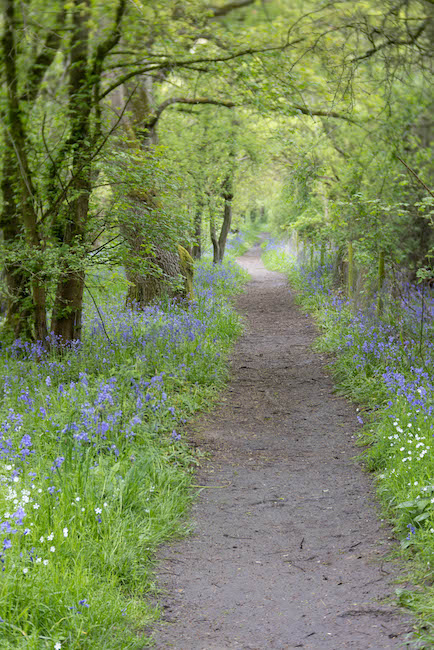
Composing photographs of bluebells
I compose shots carefully, considering foreground, middle ground, and background. I experiment with perspectives like low angles for drooping stems and high angles for an overall view.
To achieve low angles without getting me or my gear dirty, I always carry a folded plastic sheet (36" x 48") to lay on the ground and sit on.
I also try to be vigilant about stray branches or elements that can be a distraction in the frame. In the photo below you can see a light coloured piece of dried grass in the lower left corner which I would rather was missing.
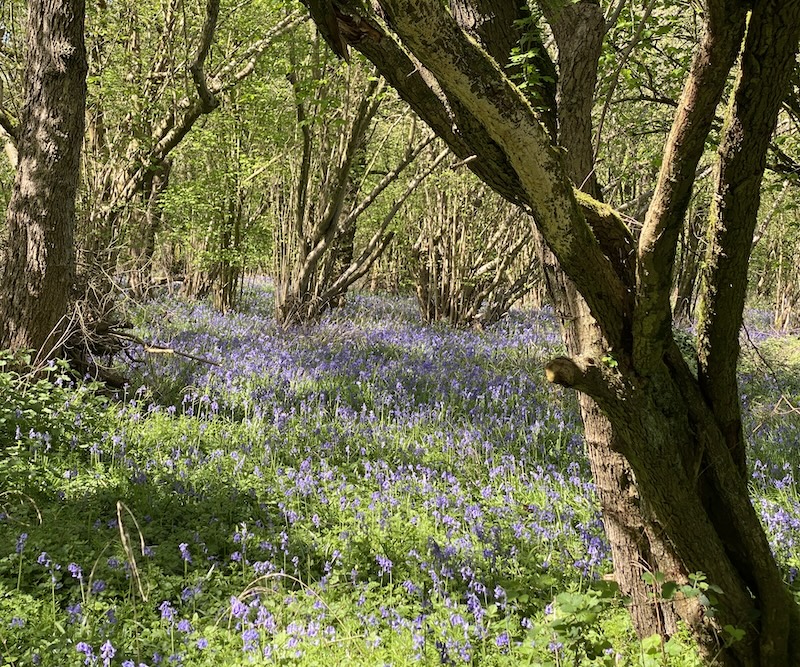 English bluebells in the wood
English bluebells in the woodSpanish bluebells vs English bluebells
Wild English bluebells and Spanish bluebells are often confused but have key differences:
Leaves: Spanish variety has wider leaves (see photos)
Flower colour: Native English are darker blue/purple; Spanish can be paler or pinky mauve
Petal tips: Native flowers have curled tips; Spanish do not
Stems: Wild English bluebell stems gracefully droop; Spanish sit on straighter stems
The Spanish variety was introduced to the UK as a garden flower.
 Spanish bluebells
Spanish bluebells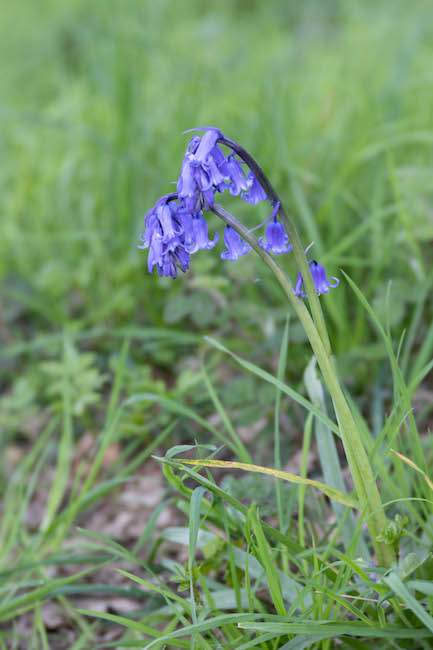 English Bluebells
English BluebellsWhy should we be concerned?
The Spanish plants are more vigorous and can outcompete or hybridise with native flowers, threatening the conservation of wild English bluebells.
Final contemplations
For me bluebell photography is not just about taking pictures. It is also about celebrating the ephemeral beauty of life itself. It's a chance to immerse myself in the beauty of the natural world, to capture a moment in time that is fleeting and yet everlasting.
Get closer to UK nature - Subscribe to Wild Lens!
I would love to send you my occasional newsletter so we can keep in touch.






